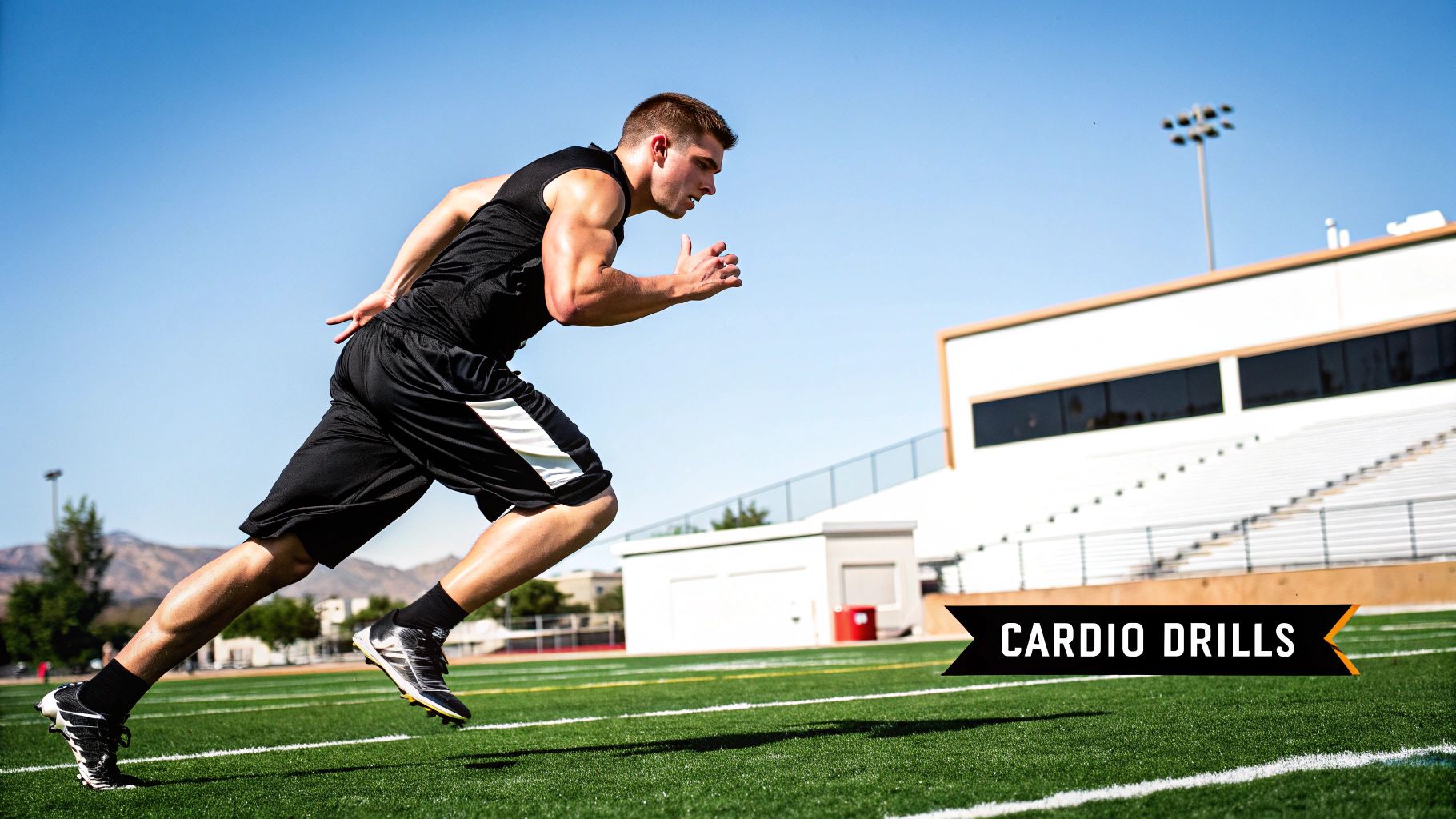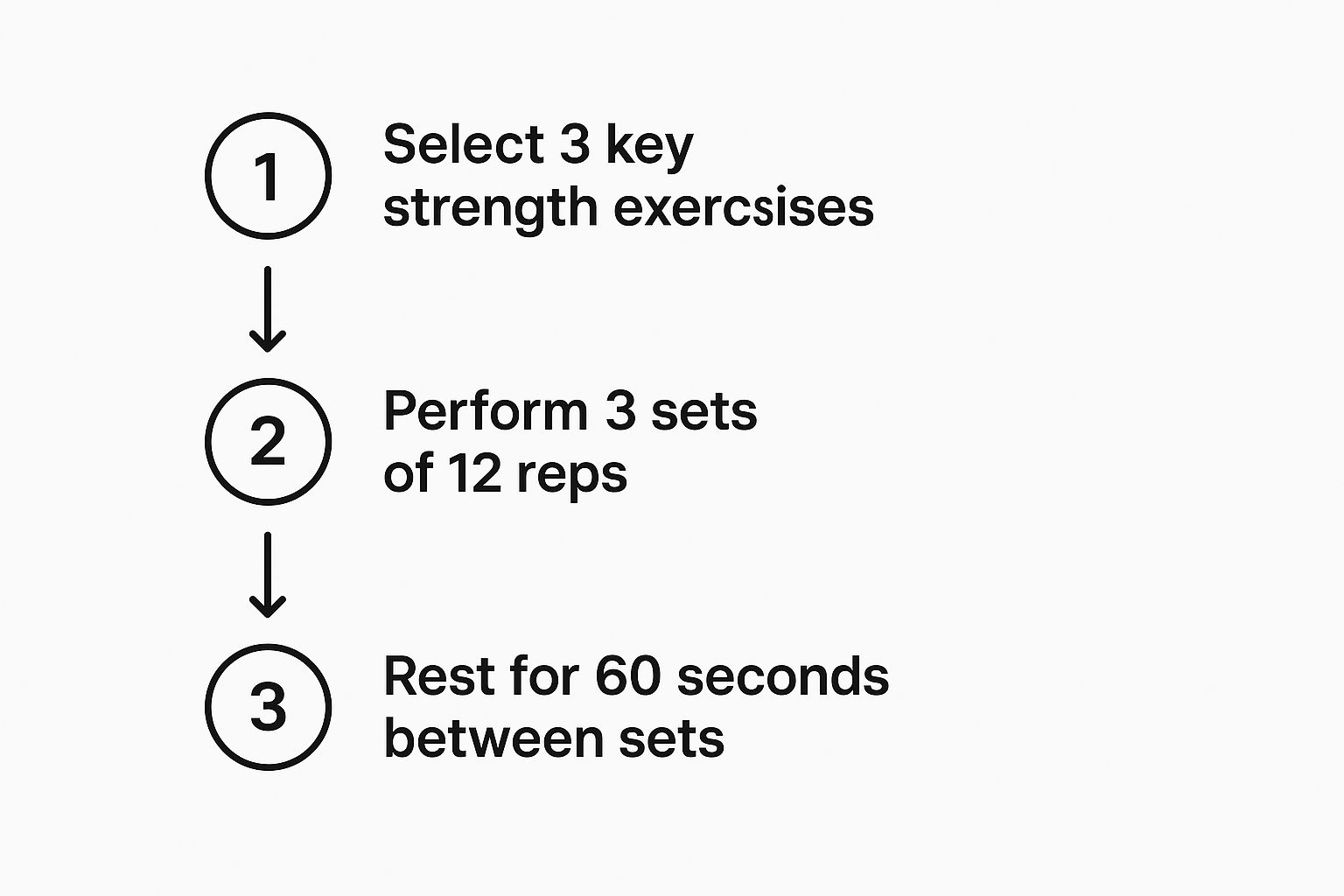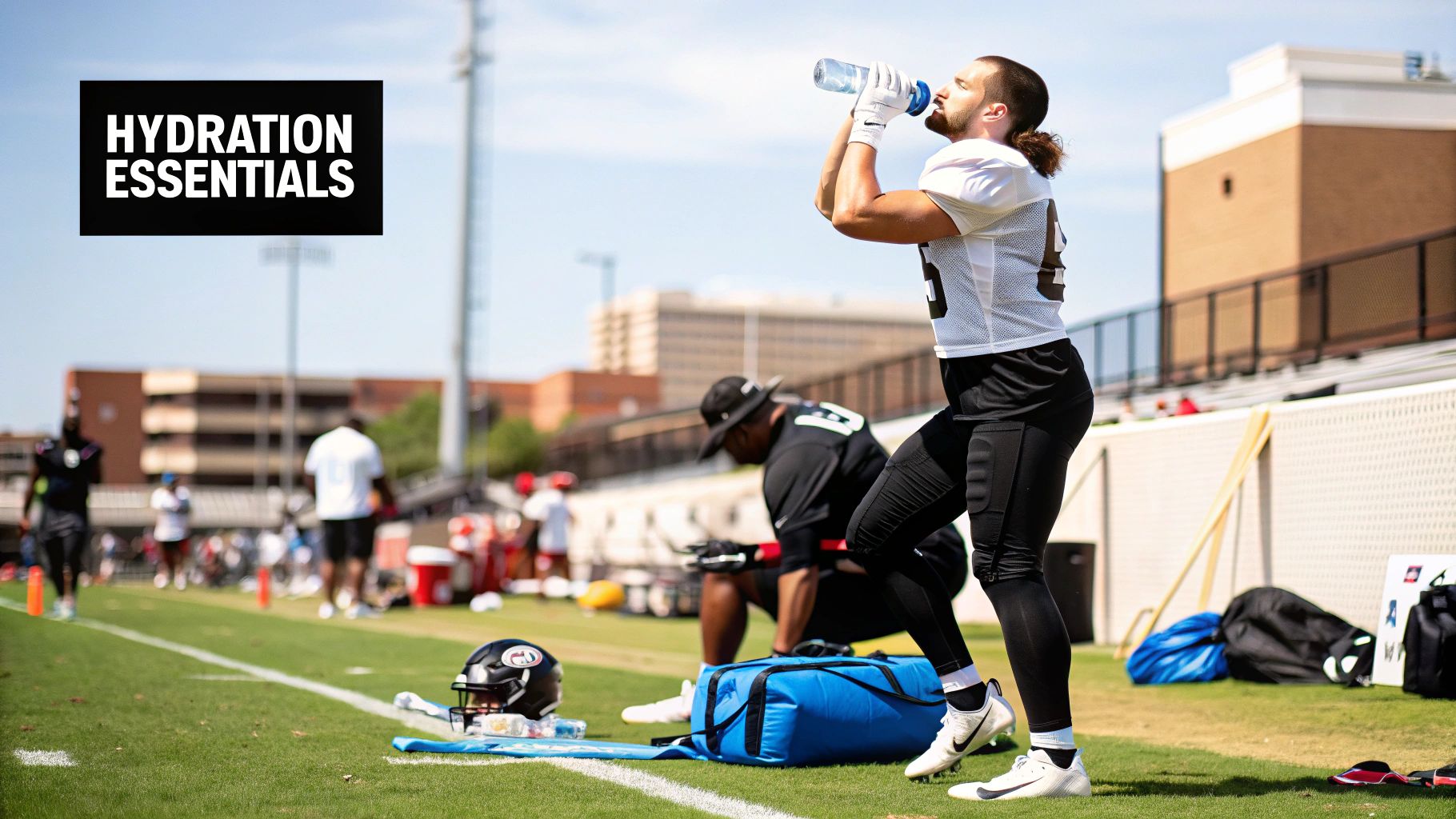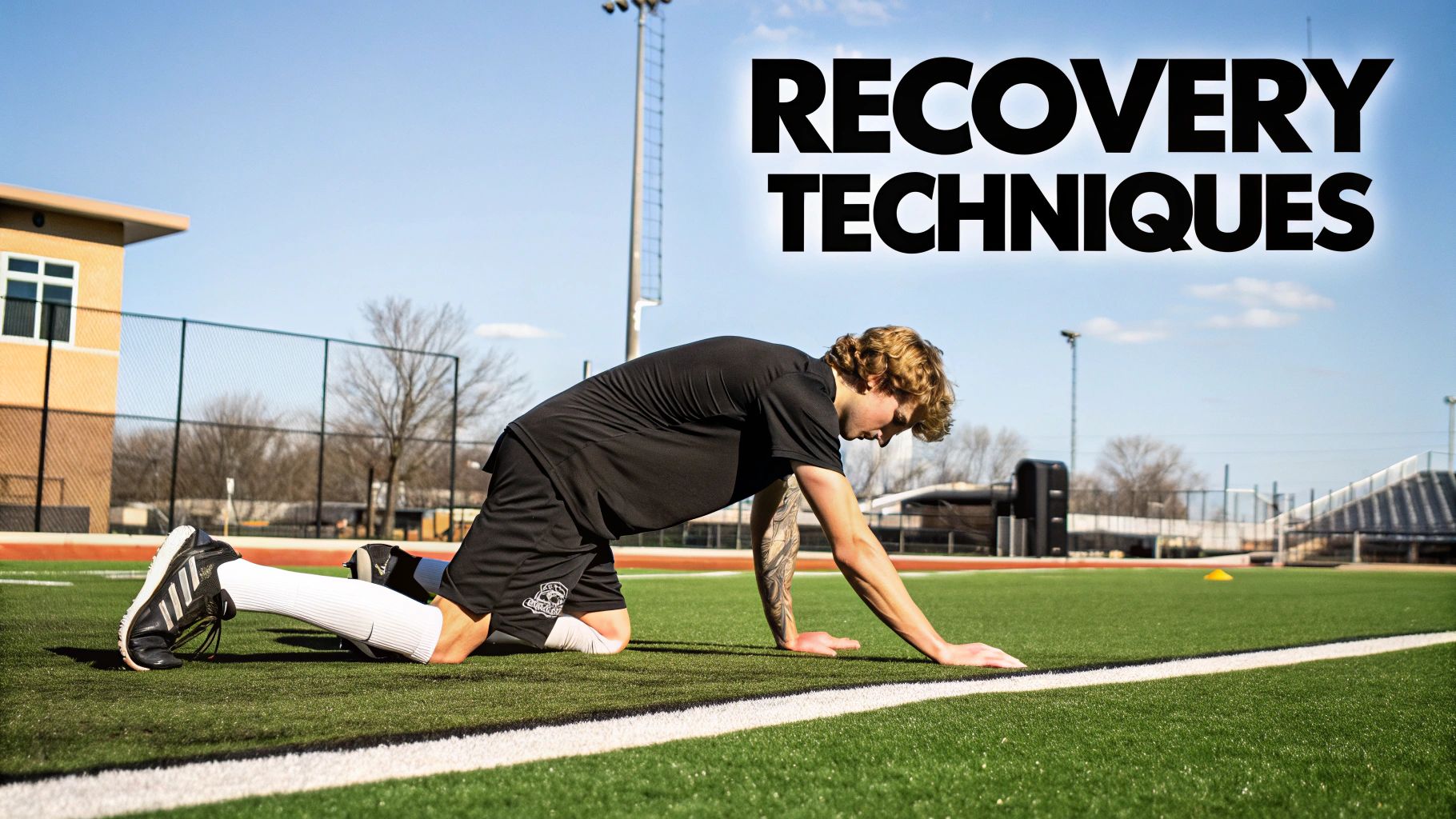If you want to build proper football stamina, you need a specific combination of training: aerobic conditioning, high-intensity intervals, and targeted strength work. Forget endless, mind-numbing jogs around the park. We’re talking about building the engine to make explosive sprints, recover in seconds, and still be going strong after 90 minutes.
What Does "Football Fit" Actually Mean?
When a player decides they need more stamina, the first instinct is nearly always the same: go for a long, slow run. While that’s not a bad thing for building a general fitness base, it completely misses the point of what it takes to dominate on the pitch.
Real football stamina isn’t just about running for ages. It’s about having the legs to make a lung-busting overlap in the 85th minute and still get back to defend. It’s recovering almost instantly after a chaotic goalmouth scramble so you’re ready for the next ball. It’s also mental—making smart, tactical decisions when your body is screaming at you to stop.
It’s Not a Marathon, It’s a Game of Bursts
Football is a game of stops and starts, of explosive bursts followed by quick recovery. That’s exactly what your training needs to mirror. An analysis of Premier League players showed they cover 10 to 13 kilometres in a match, but hidden inside that number are around 1,400 changes in activity – that’s a new action every four seconds.
Sure, 80-90% of that time is spent walking or jogging, but matches are won and lost in that other 10-20% of high-intensity sprinting and sharp changes of direction. If you want to dive deeper, you can read the full research on player physical demands.
Football fitness is all about your ability to repeat high-intensity sprints. The key isn't just how fast you can run once, but how quickly you can recover to go again at full tilt.
Your Position Dictates Your Engine
Stamina isn't a one-size-fits-all deal. A box-to-box midfielder has completely different physical demands to a centre-back, and your training should reflect that.
- Wingers and Full-Backs: You live and die by your repeat sprint ability. It’s all about non-stop attacks and tracking back down the flanks.
- Central Midfielders: You need a massive aerobic engine. You’ll cover the most ground on the pitch, connecting the defence to the attack.
- Strikers: It’s about short, sharp, explosive power. Your job is to make those clever runs that get you behind the defence in a flash.
- Centre-Backs: Your fitness is built on power for short bursts, jumping, and physically holding off attackers. Covering long distances is less of a priority.
Getting this right is the first step to smarter training. When you focus on the specific energy systems you actually use in a match, you build stamina that directly translates to your performance on the pitch. You’ll be just as strong at the final whistle as you were at kick-off.
Building Your Aerobic Base: The Engine for Endurance

Your aerobic base is the engine that powers your entire game. Without a strong one, you’ll be the player gasping for air after a few sprints, fading badly after half-time, and getting left for dead in the final, crucial minutes of a match.
Building this foundation isn't about aimless jogging. It’s about smart, structured conditioning that prepares your body for the relentless demands of a 90-minute battle. A powerful aerobic system means your body gets incredibly efficient at pumping oxygen to your muscles, which is the secret to both lasting the full game and recovering quickly between those explosive bursts.
Mastering Your Heart Rate Zones
To make every training session count, you have to train at the right intensity. This is where heart rate zones come in. It’s the most effective way to be sure you're building genuine aerobic capacity, not just logging "junk miles" that leave you tired without any real fitness gains.
A quick and easy way to estimate your maximum heart rate (MHR) is the old classic: 220 minus your age. Once you have that number, you can work out your key training zones.
-
Zone 2 (60-70% of MHR): This is your bread and butter for building endurance. You should be able to hold a conversation comfortably while running at this pace. Think of it as your long, steady run zone. It’s perfect for building mitochondrial density (the tiny powerhouses in your cells) and teaching your body to burn fat for fuel more efficiently.
-
Zone 3 (70-80% of MHR): This is your "tempo" zone. The effort feels comfortably hard, and you can only manage short phrases. Tempo runs are brilliant for training your body to clear out lactate, which is the stuff that makes your legs feel heavy and tired. The better you are at this, the longer you can work at high intensity.
Using a chest strap or a reliable sports watch is the best way to keep an eye on these zones while you train. For players who are serious about their data, a dedicated soccer GPS tracker from soccerwares.com can give you incredibly detailed insights into your heart rate, distance covered, and overall intensity.
Think of Zone 2 training as building a bigger fuel tank. Tempo runs, on the other hand, teach your engine to be more fuel-efficient. You absolutely need both to last the full 90 minutes and beyond.
Structuring Your Aerobic Training Week
So how do you fit this into an already packed football schedule without burning out? The key is balance. You can't just add endless running on top of team training and matches.
Aim for one or two dedicated aerobic sessions per week. Crucially, schedule them on days that are far away from matches to give your body a proper chance to recover. A long, steady Zone 2 run, for example, is perfect for a day off or very early in the training week.
Here’s what a simple, effective structure could look like:
- Session 1 (Early Week): A 45-60 minute steady-state run. The only goal here is to keep your heart rate smack in the middle of Zone 2. Focus on maintaining a consistent rhythm.
- Session 2 (Mid-Week): A 30-minute tempo run. After a good warm-up, spend 15-20 minutes running at your Zone 3 pace, then finish with a proper cool-down.
This combination works because it builds your endurance engine without trashing your legs or sacrificing the explosive power you need on match day. Consistency is the most important thing. Stick with it, and you'll see massive improvements.
Using High-Intensity Training to Replicate Match Day
Once your aerobic engine is built, it's time to tune it for the pitch. Football isn’t played at one steady pace; it’s a chaotic mix of explosive sprints, sharp decelerations, and brief recovery periods. This is where High-Intensity Interval Training (HIIT) becomes your most valuable tool for building proper football stamina.
HIIT is all about mirroring the brutal physical demands of a match. It trains your body to perform at maximum effort, recover in seconds, and then go again. This conditions your cardiovascular system to handle the rapid heart rate spikes that happen during a game, whether it's a sudden counter-attack or closing down an opponent.
Football-Specific HIIT Drills
Generic HIIT workouts are good, but drills that mimic actual on-pitch movements are far better. You need exercises that replicate the short, sharp bursts of energy required in a real game.
Here are a few brutally effective drills you can do, with or without a ball:
- Shuttle Runs: Set up cones at 5, 10, and 20 yards. Sprint to the first cone and back, then to the second and back, and finally to the third and back. A single rep is tough and directly simulates the acceleration and deceleration patterns you’ll use constantly.
- Box-to-Box Sprints: This is a classic for a reason. Starting on one 18-yard box line, sprint flat-out to the other and then immediately jog back. The sprint builds your top-end speed endurance, while the jog back trains your active recovery—a crucial skill.
- Possession Games Under Fatigue: Small-sided games (like 3v3 or 4v4) in a tight area are a fantastic, natural form of HIIT. The constant movement, tackling, and passing forces high-intensity efforts without you even thinking about it. To ramp it up, limit touches or shrink the playing area.
The image below gives you a simple framework for adding strength work, which is the perfect partner to your HIIT sessions for building muscular endurance.

This process shows a straightforward way to structure a supplementary strength routine, making sure your muscles have the staying power to match your cardiovascular fitness.
Mastering Work-to-Rest Ratios
The real magic of HIIT lies in the relationship between your work and rest periods. By tweaking these ratios, you can simulate different match scenarios and target specific energy systems.
A work-to-rest ratio simply defines how long you go hard compared to how long you recover. For example, a 1:2 ratio means you rest for twice as long as you work (e.g., 30 seconds of sprinting followed by 60 seconds of rest).
A player who can recover faster between sprints has a massive advantage. Manipulating your work-to-rest ratio is how you train that specific ability. It's about teaching your body to be ready for the next play almost instantly.
Let's look at some football-specific examples:
- 1:4 Ratio (e.g., 15s sprint, 60s walk/jog): This is ideal for developing pure speed and power endurance. It mimics making a long, gut-busting run down the wing and then having a bit of time to get back into position.
- 1:1 Ratio (e.g., 30s intense drill, 30s rest): This ratio is perfect for replicating the relentless pressure of a midfield battle. You’re constantly engaged, with very little downtime. This builds incredible stamina for those sustained high-intensity periods in a match.
We recommend starting with a ratio that allows for more recovery, like 1:3 or 1:4. As your fitness improves, you can progressively shorten that rest period, moving towards a more demanding 1:2 or even a killer 1:1 ratio. This progression ensures you are constantly challenging your body to adapt and improve.
Strength and Conditioning for Power Endurance

Pitch running is non-negotiable, but true 90-minute stamina is built in the gym as much as on the grass. You can have the best engine in the world, but if your muscles give out in the 70th minute, your performance will drop off a cliff. This is where proper strength and conditioning work comes in.
We’re not talking about bodybuilding here. This is all about developing power endurance—the ability to repeatedly produce powerful movements like jumping for a header, shrugging off a defender, or sprinting onto a through ball without losing your edge. It's about building functional strength that translates directly to the pitch.
Core Exercises for Functional Football Strength
Forget isolation exercises like bicep curls or leg extensions. Your focus should be on big, compound movements that recruit multiple muscle groups at once, mimicking the demands of a real match.
A well-rounded routine should be built on these cornerstones:
- Squats: The undisputed king for lower-body power. Squats build raw strength in your quads, hamstrings, and glutes, which is the engine for sprinting and jumping.
- Deadlifts: Perfect for developing your entire posterior chain (the muscles down your back, glutes, and hamstrings). This is where the raw power for acceleration comes from.
- Lunges: These are fantastic for building single-leg strength and stability. So much of football is played on one leg, whether you're shooting, changing direction, or making a last-ditch tackle.
Focusing on these core lifts will build a body that can withstand physical challenges and still produce force deep into the second half.
Building Explosive Power with Plyometrics
Raw strength is one thing, but applying it quickly is what really counts on the pitch. This is where plyometrics, or jump training, becomes a game-changer. These drills train your muscles to produce maximum force in the minimum amount of time.
Using simple but effective tools can make a huge difference here. Incorporating gear like agility ladders and hurdles into your routine improves coordination and explosive power. If you are looking to upgrade your setup, you can find a great range of professional football training equipment to add variety and challenge to your sessions.
Strength training in youth footballers has been shown to produce not only improved stamina and on-field performance but also a significant reduction in injury risk.
Don't just take our word for it. Studies have shown that in a typical match, around 20% of the game is spent in high-intensity running, with 11% being all-out sprinting. Strengthening your muscles is key to handling these repeated bursts. You can learn more about the health benefits of football and training and see how this all connects.
This foundational strength work, combined with your on-pitch conditioning, is the real secret to building stamina that actually lasts.
Fuel Your Performance with Smart Nutrition and Hydration

All the gruelling training in the world is wasted if you don't have the right fuel in the tank. You cannot out-train a poor diet. The food and drink you consume are the absolute foundation of your energy, recovery, and ultimately, your ability to keep going for a full 90 minutes.
Smart nutrition for football stamina isn't about complicated meal plans or restrictive diets. It’s about understanding what your body needs and when it needs it. Think of your body as a high-performance engine; it needs the right type of fuel at the right time to perform at its peak.
The Macronutrients That Matter
Your energy levels are directly linked to three key macronutrients. Getting this balance right is non-negotiable for any footballer looking to improve their endurance.
- Carbohydrates: This is your primary energy source. Carbs are stored in your muscles as glycogen, which is the high-octane fuel your body burns during intense exercise. Keeping these stores topped up is vital for match day.
- Protein: This is all about muscle repair and growth. After a tough training session or match, protein gets to work rebuilding the micro-tears in your muscles, making them stronger and more resilient for the next game.
- Healthy Fats: These are brilliant for supporting overall health and hormone function, but they also provide a secondary, slow-release energy source. This is especially important for those periods in a match where the intensity drops slightly.
Focus on whole foods—things like lean meats, complex carbs like whole-wheat pasta and potatoes, and healthy fats from avocados and nuts. This gives your body the quality building blocks it needs to perform.
Timing Your Fuel for Peak Performance
Knowing what to eat is only half the battle. Knowing when to eat it is just as important, and it can make a massive difference to your on-pitch stamina.
For a match, aim to get a good, carbohydrate-rich meal in 2-3 hours beforehand. This gives your body plenty of time to digest and top up its glycogen stores without you feeling heavy or bloated at kick-off.
After the final whistle, the focus shifts to recovery. Getting a mix of protein and simple carbohydrates in within 30-60 minutes is the goal. This helps to rapidly replenish your energy stores and kick-start that all-important muscle repair process.
Dehydration is a stamina killer. Losing just 2% of your body weight in fluid can lead to a huge drop in performance, affecting everything from your speed to your decision-making.
The Critical Role of Hydration
Hydration is arguably the most overlooked part of football nutrition, yet it’s one of the most critical for maintaining stamina. When you sweat, you don't just lose water; you lose essential electrolytes like sodium and potassium, which are vital for muscle function and preventing cramp.
Staying consistently hydrated throughout the day is far more effective than just downing a bottle of water right before a game. Carry a water bottle with you and sip on it regularly.
During intense training or on match day, an electrolyte drink can be a game-changer, helping to replace what you're losing through sweat. For those who want to get really specific, learning about soccer GPS tracking can provide incredible data on your exertion levels, reinforcing just how important a proper fuelling and hydration strategy really is.
Smart Recovery and Position-Specific Training
Intense training breaks your body down; smart recovery is what builds it back up stronger. Pushing through gruelling sessions without dedicating time to proper rest is a fast track to burnout, fatigue, and injury.
Think of recovery not as downtime, but as an essential part of your training programme.
The non-negotiables are simple but incredibly effective. Aim for 7-9 hours of quality sleep per night—this is when your body does most of its repair work. Active recovery sessions, like a gentle swim or a light cycle the day after a match, are brilliant for flushing out lactic acid and reducing muscle soreness.
Tailoring Stamina to Your Role
Building your engine isn’t a one-size-fits-all process. The stamina demands of a box-to-box midfielder are worlds apart from those of a centre-back. To truly improve, you have to train for the specific challenges of your position on the pitch.
This position-specific approach ensures that every drop of sweat translates directly into better on-field performance. For example, research into the endurance capacity of professional footballers found that midfielders consistently show the highest aerobic endurance. You can explore more about these positional differences in player endurance.
Your position dictates the type of engine you need. A winger needs a Formula 1 engine for repeated sprints, while a central midfielder needs the ultra-reliable endurance engine of a Le Mans car.
Position-Specific Training Examples
Let's make this practical. Your stamina drills should reflect the movements you make most often during a match.
- For Wingers and Full-Backs: Focus on repeated sprint ability. Your drills should involve sprinting the length of the touchline, followed by a short jog back. Repeat this 8-10 times to build resistance to fatigue.
- For Central Midfielders: Your goal is high-volume running. Box-to-box shuttle runs are perfect. Sprint from your own 18-yard box to the opposition's, then jog back, simulating your role in both attack and defence.
- For Centre-Backs: Stamina here is all about short, powerful bursts. Incorporate drills that involve 5-10 yard sprints to close down an attacker, followed by immediate backpedalling. Our guide on effective defence soccer drills offers excellent examples you can adapt.
By aligning your conditioning with your specific role, you build stamina that is not just general fitness, but genuinely match-winning endurance.
At SoccerWares, we provide the gear that helps you train smarter and recover better. Explore our collection to find the essentials you need to elevate your game.

